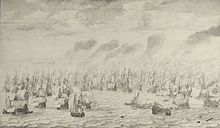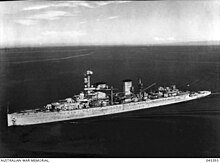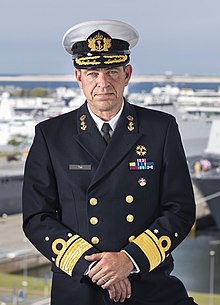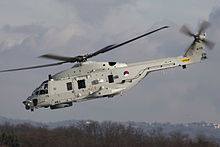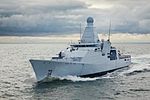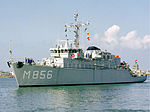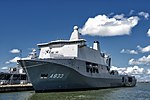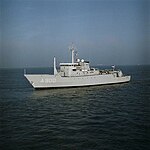
The Netherlands Armed Forces are the military services of the Kingdom of the Netherlands. The core of the armed forces consists of the four service branches: the Royal Netherlands Navy, the Royal Netherlands Army, the Royal Netherlands Air Force and the Royal Netherlands Marechaussee. The service branches are supplemented by various joint support organisations. In addition, local conscript forces exist on the Dutch Caribbean islands of Aruba (AruMil) and Curaçao (CurMil). These operate under the auspices of the Royal Netherlands Navy and the Netherlands Marine Corps. The armed forces are organisationally part of the Ministry of Defence.

HNLMS Van Speijk (F828) is the eighth and last ship in the Karel Doorman class of multi-purpose frigates, used by the Royal Netherlands Navy.

The Karel Doorman-class frigates are a series of eight multi-purpose vessels built for the Royal Netherlands Navy. Its namesake is Karel Doorman, a Dutch naval officer whose ship was struck by a Japanese torpedo in the battle of the Java Sea in 1942, and who, as a result of which, went down with his ship.
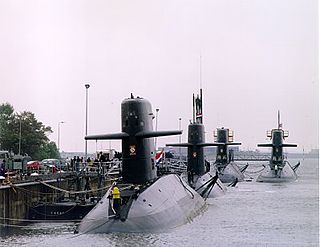
The Walrus-class submarine is the only submarine class currently in operation in the Royal Netherlands Navy. The boats have been in service since 1990 and are all named after sea mammals.

HNLMS Walrus (S802) was a Walrus-class submarine of the Royal Netherlands Navy. After a long delay following a serious fire during construction, the submarine entered service in 1992. Walrus was deployed both for naval exercises and in combat operations around the world. She was decommissioned in October 2023.

HNLMS Tromp (F803) is the second De Zeven Provinciën-class frigate of the Royal Netherlands Navy. The ship was laid down in 1999, launched in 2001, and commissioned in 2003. The frigate is named after Dutch naval heroes Maarten Tromp (1598–1653) and Cornelis Tromp (1629–1691).

HNLMS De Ruyter is a De Zeven Provinciën-class frigate of the Royal Netherlands Navy. She was laid down in 2000, launched in 2002, and commissioned in 2004, the third ship of her class to enter service. The frigate is named after Dutch admiral Michiel de Ruyter (1607–1676).

HNLMS Karel Doorman is a multi-function support ship for amphibious operations of the Royal Netherlands Navy, which is also used by the German Navy. The ship replaced both of the navy's replenishment oilers: HNLMS Zuiderkruis and HNLMS Amsterdam. At 204.7 m she is the largest ship in service with the Royal Netherlands Navy.

HNLMS Rotterdam is the lead ship in the Rotterdam-class landing platform dock of the Royal Netherlands Navy. The ship is named after the Dutch city of Rotterdam.

HNLMS Mercuur (A900) is a submarine support ship of the Royal Netherlands Navy. The ship was built and designed specially to support the Dutch submarines. She entered service on 21 August 1987, and is the only surface vessel attached to the Dutch submarine service.
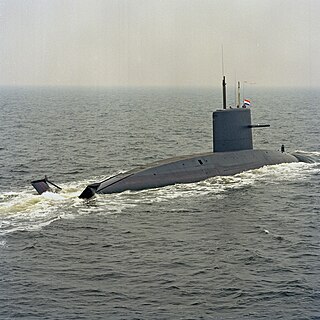
HNLMS Zeeleeuw (S803) is a Walrus-class submarine of the Royal Netherlands Navy. She entered service in 1990 as the first submarine of the Walrus class, after the intended lead ship, HNLMS Walrus, was delayed for a long period following a serious fire during construction. Zeeleeuw has been deployed both for naval exercises and in combat operations around the world. Furthermore, the submarine plays an important role by performing intelligence operations. The submarine has undergone a mid-life maintenance and upgrade program between 2014 and 2016, and is currently in active service.

HNLMS Dolfijn (S808) is a Walrus-class submarine of the Royal Netherlands Navy. She entered service in 1993 as the third submarine of the Walrus class, after HNLMS Walrus and HNLMS Zeeleeuw. Dolfijn has been deployed both for naval exercises and in combat operations around the world. Furthermore, the submarine plays an important role by performing intelligence operations.

HNLMS Bruinvis (S810) is a Walrus-class submarine of the Royal Netherlands Navy. She entered service in 1994 as the fourth and final submarine of the Walrus class, after HNLMS Walrus, Zeeleeuw and Dolfijn. Bruinvis has been deployed both for naval exercises and in combat operations around the world. As of December 2015 the submarine was in active service.

HNLMS Holland is the first ship of the Holland-class offshore patrol vessels of the Royal Netherlands Navy. The ship was originally designed to fulfill patrol and intervention tasks against lightly armed opponents, such as pirates and smugglers. However, it also has very advanced electronic and radar surveillance capabilities which are used for military stabilization and security roles, short of outright war. Without sonar or long range weapons, it utilizes the surveillance capabilities of the Thales integrated mast, which integrates communication systems and two 4-faced phased arrays for air and surface search.
In April 2018, the Dutch Government approved a multi-year investment program for the Dutch Navy and allocated funds for the 2018–2030 period. The Dutch Defence Materiel Administration (DMO) is in charge of the procurement of these new ships.

HNLMS Den Helder is a new replenishment oiler under construction for the Royal Netherlands Navy. Also known as the Combat Support Ship (CSS), Den Helder is planned to fill the gap of replenishment at sea that was left after HNLMS Amsterdam was sold to Peru in 2014.

The Netherlands and Belgium are doing a joint procurement for the replacements of the Tripartite-class/Alkmaar-class minehunters. Each of the two countries is procuring six new mine countermeasure (MCM) vessels, which makes for a total of 12 MCM ships. The new MCM ships, developed by Naval Group, will include a range of unmanned systems including unmanned surface, aerial and underwater vehicles alongside towed sonars and mine identification and neutralization ROVs.

The Snellius class are two hydrographic survey vessel (HOV) ships in service with the hydrographic branch of the Royal Netherlands Navy. The ships were built by the Damen Group, with the hull being built in Romania by Damen Shipyards Galați and the fitting out in the Netherlands by Damen Schelde Naval Shipbuilding.
The West Indies Guard Ship (WIGS) is a ship of the Royal Netherlands Navy that rotates about every four to six months in support of the Dutch Caribbean Coast Guard. It can be a frigate but more commonly one of the navy's Holland-class offshore patrol vessels is deployed to the region. This vessel usually carries an NHIndustries NH90 helicopter for search and rescue tasks and pursuit of suspect vessels.





